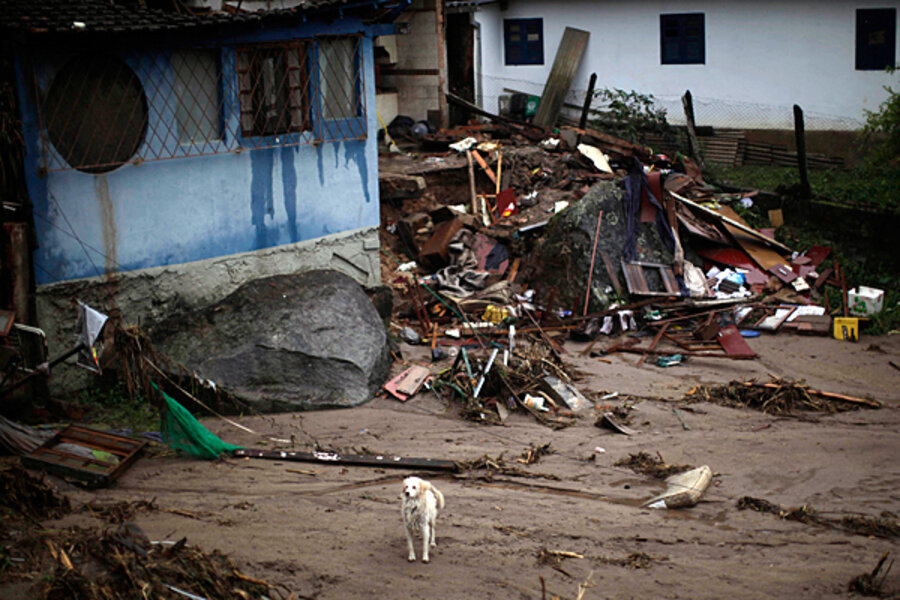Even with Brazil flooding expected to continue, many remain in perilous areas
Loading...
| Teresópolis, Brazil
Ilderjone Dias stares down at the mud. A roof is poking up from the hardening brown sludge, and Mr. Dias points to 14 surrounding spots where he and other rescue workers have pulled 14 bodies from the mud, among more than 500 people who have died over the past week in the Brazil floods.
But his own home is still intact nearby on a steep hill, and he doesn't plan on leaving. “I believe it won’t fall,” Dias says.
Dias is one of tens of thousands of Brazilians living in the hillside homes in the city of Teresópolis, one of the worst-hit areas in the summer flooding. He and many others living in the most landslide-prone neighborhoods say they won't flee for safer ground, despite more rains predicted through the weekend.
Their resistance to flee is itself a reason the death toll has risen so fast amid the heavy rains. While analysts have blamed the federal government for slashing its budget for disaster preparedness, and the government has blamed municipal authorities for lax oversight of home building, many shantytown residents themselves say that they're resolved to continue living on the precarious hillsides.
In Brazil, 'hill' is synonym for slum
Teresópolis and the two nearby cities of Petrópolis and Nova Friburgo bore the brunt of heavy rains starting Tuesday night that have already brought the worst natural disaster in Brazilian history. Carlos Minc, the environment secretary of Rio de Janeiro state, told reporters today that 5,000 homes remain at risk in these three cities and that families must move to safer ground.
While long accustomed to lethal annual flooding, Brazil's previous highest death tolls from flooding and mudslides was 316 in 2010 and about 200 in 1966, according to daily newspaper El O Globo. Here in Teresópolis, popular as a breezy mountain getaway less than two hours from the city of Rio de Janeiro, at least 223 bodies have been recovered.
Despite Brazil's southeast's reputation as the most-developed corner of the country, floods continue to bring stunningly high death tolls to Rio de Janeiro and São Paulo.
One recurring reason? The often poor-quality homes built informally on precarious inclines in Brazil’s saturated urban centers, like the Caleme neighborhood. The correlation between Rio de Janeiro’s shantytowns (known as favelas) and its characteristically jagged hills is so strong that morro (hill) is a common synonym for “slum,” and asfalto (asphalt), for the higher-quality neighborhoods below.
Convincing residents to leave
“Many people refuse to leave. … I can’t obligate them,” says Herculano Abrahão, who leads the Red Cross unit at the gymnasium in downtown Teresópolis that serves as a makeshift shelter and check-in point for those looking for information on loved ones. Nearly 800 homeless and 300 volunteers have already arrived at this gym and smaller nearby shelters, which feel like a nursery as kids play on the court and tired but relieved adults lay on mattresses and repeat the same refrain: We don’t know where we’ll go next.
Mr. Abrahão expects survivors to stay in the gymnasium for at least two more weeks. But he admits that a problem going forward is actually getting families and particularly the elderly in high-risk areas to come to the shelter before – and not after – their house falls. “It’s a very delicate situation,” he adds.
Back in Dias's neighborhood of Caleme, two gray-haired retirees also say they’re not leaving their homes, even as they point to houses above and below that appear in danger of collapsing. But these women are more afraid of looters.
“How am I going to leave? I am retired, my husband is retired,” says one, who owns a small store attached to her house on the border of a mudslide. She points at her swollen feet and asks how she would get down to the city’s gymnasium shelter. “It doesn’t help anything to go there and then return here,” she adds.
But their neighbor Luciana Moraes Soares, carrying bags of clothes down the muddy path, tells Dias she disagrees with him and it’s better stay away from the hilltop for the next few days. She’s rooming with a friend on the flat area below the hill. “We couldn’t imagine that this would happen someday,” she says.





